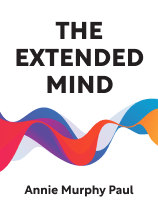

This article is an excerpt from the Shortform book guide to "The Extended Mind" by Annie Murphy Paul. Shortform has the world's best summaries and analyses of books you should be reading.
Like this article? Sign up for a free trial here.
Why should you write down your thoughts? What are the cognitive benefits?
The Extended Mind is a book about how to achieve optimal cognition by catering to your brain’s biology. In the book, science writer Annie Murphy Paul explains that writing down your thoughts is one of the best ways to enhance your cognition.
Read on to learn about the benefits of writing down your thoughts and Paul’s tips for getting started.
Why Write Down Your Thoughts?
In The Extended Mind, Annie Murphy Paul claims that you can use external aids to enhance your cognition by more intentionally engaging with the immediate physical world around you. Specifically, she suggests you write down your thoughts (or use other creative methods) and give them a physical form to think more effectively.
In this article, we’ll examine Paul’s strategy for giving your thoughts a physical form by writing them down or otherwise getting them outside of your mind, according to the advice in The Extended Mind.
Give Your Thoughts Physical Form
If you’re trying to learn something, solve a problem, or generate new insights, Paul recommends giving your thoughts physical form—whether by writing them down, representing them in images, or modeling them in some other tactile way. Moving your thoughts from your head into the physical world means that you don’t have to actively remember as much, giving you more mental capacity to think effectively.
(Shortform note: Many experts argue that a strict system dictating how to habitually externalize your thoughts is the key to personal organization. For instance, The Bullet Journal Method, Getting Things Done, and Building a Second Brain all offer distinct, intricate systems of organizing your thoughts outside of your head. These systems have much in common: They detail how to sort the information you record, as well as how and when to review and act on that information.)
If you can write down your thoughts and give them a physical form that you’re able to physically manipulate, that’s even better, according to Paul. Biologically speaking, the brain is much better at making sense of physical objects than abstract ideas, so you’ll get better results working through your thoughts with your hands than in your mind. For example, if you’re trying to determine a seating arrangement for your wedding reception, you could write your guests’ names on slips of paper and physically move them around until you’ve found the ideal configuration.
(Shortform note: If your thoughts or ideas are too big or complex for you to write down, you may be able to replicate the experience of thinking with your hands using 3D modeling software. Software like this allows you to design and manipulate objects in a virtual, three-dimensional space. Although you’ll lose the tactile sensations that aid cognition, the ability to free up your working memory by externalizing spatial ideas is still invaluable.)
Additionally, Paul explains that writing down your thoughts creates distance from them, allowing you to judge them more clearly and objectively. This distance also helps you come up with creative new ideas, as inspecting your thoughts externally helps you see them in new ways.
Paul states that this understanding should completely change the way you approach the creative process. When you’re doing anything creative, many people assume that you should come up with an idea, work out all the details, then manifest it in the world as a finished product. However, Paul argues that the ideal creative process is iterative: Write down your thoughts, assess them, and repeat. By critiquing and finding inspiration in each successive draft, you’ll end up with a much better final product.
(Shortform note: The creative process Paul outlines here closely mirrors Stephen King’s writing process as he describes it in On Writing. King almost always creates multiple drafts when writing his novels. Like Paul, King acknowledges that attaining distance from your work helps you cultivate a clearer perspective and come up with better ideas. Therefore, to create even more distance, King recommends that you write a first draft as quickly as possible and then work on other projects for a while before returning to revise. King takes at least six weeks between finishing his first draft and revising one of his pieces.)

———End of Preview———
Like what you just read? Read the rest of the world's best book summary and analysis of Annie Murphy Paul's "The Extended Mind" at Shortform.
Here's what you'll find in our full The Extended Mind summary:
- Why you don't need to withdraw into your mind to achieve optimal cognition
- Cognitive strategies and habits that will help you better understand complex ideas
- How gesturing with your hands helps you think better






